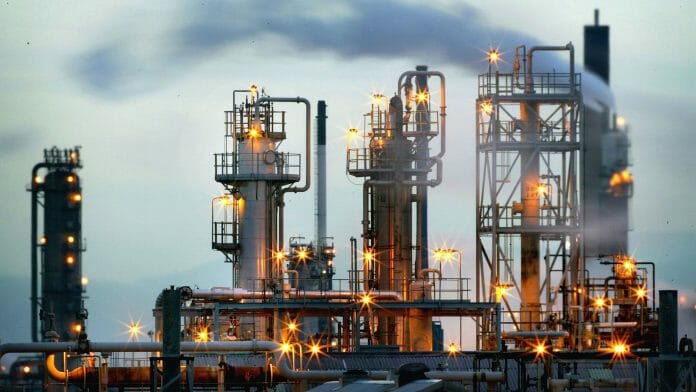Oil will rise back above US$100 (RM425.80) a barrel this year and may face a serious supply problem in 2024 as spare production capacity runs out, says Goldman Sachs Group Inc.
With sanctions likely to cause Russian oil exports to drop and Chinese demand expected to recover as the country ends its zero-Covid policy, prices will rise above US$100 from their current level of around US$80 (RM340.64), according to Goldman.
A lack of spending in the industry on production needed to meet demand will also be a driver of higher prices, and this lack of capacity may become a big issue by 2024, analyst Jeff Currie told Bloomberg on the sidelines of a conference in Riyadh, Saudi Arabia.
“The commodity super cycle is a sequence of price spikes, with each high higher and each low higher,” said Currie, who heads commodities research at Goldman.
By May, oil markets should flip to a deficit of supply compared to demand, he said. That could use up much of the unused capacity global producers have, which will be positive for prices, he added.
Oil prices have had a volatile few years, plunging below US$20 (RM85.16) during the coronavirus pandemic before soaring close to US$130 (RM553.54) after Russia’s invasion of Ukraine disrupted supply that was already falling short of global demand.
The cost of transport fuels rose higher as refineries maxed out capacity before falling back as countries scrambled for alternatives.
Saudi Energy Minister Prince Abdulaziz bin Salman also used remarks at the Riyadh conference to decry the lack of investment in refining capacity that has left the world undersupplied.
He reiterated that the Organisation of Petroleum Exporting Countries and its allies (Opec+) would remain cautious in deciding when to ramp up output.
Saudi Arabia is the de facto leader, along with Russia, of the group that brings together Opec and other producers in an effort to balance supply and demand, while keeping prices palatable for members.
Prince Abdulaziz said the cartel’s efforts at limiting supply had saved oil markets during the plunge in demand during the pandemic.
Currie reiterated Goldman’s view that Opec+ will unwind production limits and look to raise output later this year. An Opec+ market monitoring committee this month recommended that the group keep oil output unchanged.
“Right now, we’re still balanced to a surplus because China has yet to fully rebound,” Currie said. Capacity is likely to become a problem later this year when demand outstrips supply, he said.
“Are we going to run out of spare production capacity? Potentially, by 2024, you will start to have a serious problem.”
Oil prices rise 1% in choppy trade on China demand hopes
Meanwhile, oil prices edged higher in choppy trading on Monday (Feb 6) as markets weighed a return in demand from China against supply concerns and fears of slower growth in major economies curbing consumption.
Brent futures for April delivery rose US$1.05, or 1.3%, to US$80.99 (RM345.42) a barrel, after trading between US$79.10 and US$81.25.
West Texas Intermediate crude (WTI) gained 72 cents, or 1%, to US$74.11 (RM316.08) per barrel, after hitting a high of US$74.41 and a low of US$72.25.
Prices were buoyed by prospects for China’s recovery after the relaxation of Covid-19 restrictions.
The International Energy Agency (IEA) expects half of this year’s global oil demand growth to come from China, the agency’s chief said on Sunday, adding that jet fuel demand was surging.
Holding back gains however, Friday’s blowout US employment number raised expectations that the Federal Reserve’s rate increases will not end with a hard economic landing, and that the US central bank may have more than one more rate increase left, which could curb economic growth and lower fuel demand.
The dollar also rose to a three-week high against the euro on Monday. A stronger dollar typically reduces demand for dollar-denominated oil from buyers paying with other currencies.
“You’ve got a strong dollar, you’re in a generally risk-off environment,” Reuters quoted Robert Yawger, executive director of energy futures at Mizuho saying.
WTI and Brent had slid 3% last Friday after the strong US jobs data.
Supply concerns continued to affect markets as operations at Turkey’s oil terminal in Ceyhan halted after a major earthquake hit the region.
The BTC terminal, which exports Azeri crude oil to international markets, will be closed on Feb. 6-8 while operators assess earthquake damage, a Turkish shipping agent said.
However, a preliminary Reuters poll showed that US crude oil stockpiles likely rose by about 2.2 million last week.
Also, price caps on Russian products took effect on Sunday, with Group of Seven nations, the European Union and Australia agreeing on limits of US$100 a barrel on diesel and other products that trade at a premium to crude and US$45 a barrel for products that trade at a discount, such as fuel oil.









